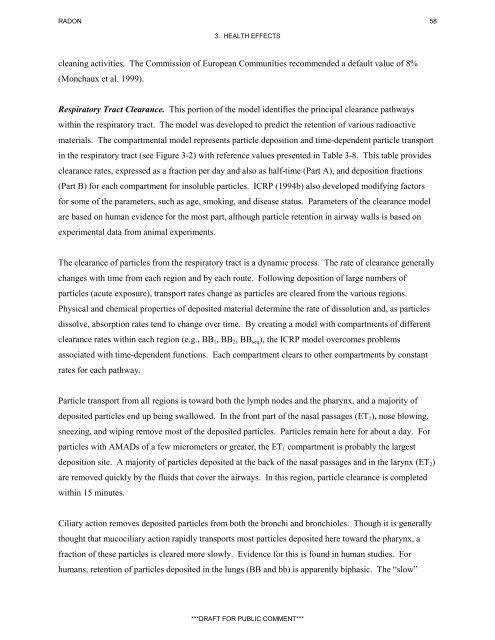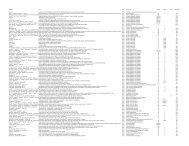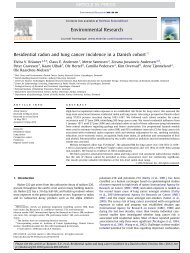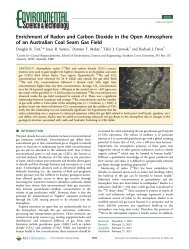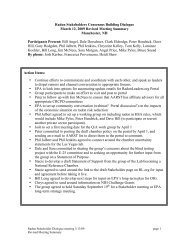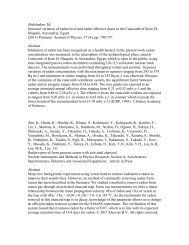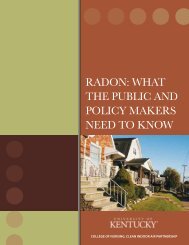- Page 1 and 2:
DRAFTTOXICOLOGICAL PROFILE FORRADON
- Page 3 and 4:
RADONiiiUPDATE STATEMENTA Toxicolog
- Page 5 and 6:
RADONvFOREWORD This toxicological p
- Page 7 and 8:
RADONviiQUICK REFERENCE FOR HEALTH
- Page 9 and 10:
RADONixThe American College of Occu
- Page 11 and 12:
RADONxiCONTRIBUTORSCHEMICAL MANAGER
- Page 13 and 14:
RADONxiiiPEER REVIEWA peer review p
- Page 15 and 16:
RADONxvCONTENTSDISCLAIMER .........
- Page 17 and 18:
RADONxvii5. PRODUCTION, IMPORT/EXPO
- Page 19 and 20:
RADONxixLIST OF FIGURES3-1. Concept
- Page 21 and 22:
RADONxxiLIST OF TABLES3-1. Selected
- Page 23 and 24:
RADON11. PUBLIC HEALTH STATEMENTThi
- Page 25 and 26:
RADON 31. PUBLIC HEALTH STATEMENT1.
- Page 27 and 28:
RADON 51. PUBLIC HEALTH STATEMENT1.
- Page 29 and 30: RADON71. PUBLIC HEALTH STATEMENTAdd
- Page 31 and 32: RADON92. RELEVANCE TO PUBLIC HEALTH
- Page 33 and 34: RADON 112. RELEVANCE TO PUBLIC HEAL
- Page 35 and 36: RADON 133. HEALTH EFFECTS3.1 INTROD
- Page 37 and 38: RADON 153. HEALTH EFFECTSin 1 L of
- Page 39 and 40: RADON 173. HEALTH EFFECTSselected d
- Page 41 and 42: RADON 193. HEALTH EFFECTStoxicologi
- Page 43 and 44: RADON 213. HEALTH EFFECTSTable 3-2.
- Page 45 and 46: RADON 233. HEALTH EFFECTSTable 3-3.
- Page 47 and 48: RADON 253. HEALTH EFFECTSvalue is s
- Page 49 and 50: RADON 273. HEALTH EFFECTSassessment
- Page 51 and 52: RADON 293. HEALTH EFFECTSsome cohor
- Page 53 and 54: RADON 313. HEALTH EFFECTSAssessment
- Page 55 and 56: RADON 333. HEALTH EFFECTS3.2.3 Derm
- Page 57 and 58: RADON 353. HEALTH EFFECTSTable 3-6.
- Page 59 and 60: RADON 373. HEALTH EFFECTSof water (
- Page 61 and 62: RADON 393. HEALTH EFFECTSof the tox
- Page 63 and 64: RADON 413. HEALTH EFFECTSand Strong
- Page 65 and 66: RADON 433. HEALTH EFFECTSKinetics o
- Page 67 and 68: RADON 453. HEALTH EFFECTSinitiating
- Page 69 and 70: RADON 473. HEALTH EFFECTSDisease Re
- Page 71 and 72: RADON 493. HEALTH EFFECTSpharmacody
- Page 73 and 74: RADON 513. HEALTH EFFECTSFigure 3-1
- Page 75 and 76: RADON 533. HEALTH EFFECTSHuman Resp
- Page 77 and 78: RADON 553. HEALTH EFFECTSTable 3-7.
- Page 79: RADON 573. HEALTH EFFECTSFigure 3-3
- Page 83 and 84: RADON 613. HEALTH EFFECTSaction of
- Page 85 and 86: RADON 633. HEALTH EFFECTS• For Ty
- Page 87 and 88: RADON 653. HEALTH EFFECTSinterstiti
- Page 89 and 90: RADON 673. HEALTH EFFECTSin the sto
- Page 91 and 92: RADON 693. HEALTH EFFECTSFigure 3-7
- Page 93 and 94: RADON 713. HEALTH EFFECTScoefficien
- Page 95 and 96: RADON 733. HEALTH EFFECTSinformatio
- Page 97 and 98: RADON 753. HEALTH EFFECTSdamage can
- Page 99 and 100: RADON 773. HEALTH EFFECTSeliminatio
- Page 101 and 102: RADON 793. HEALTH EFFECTSA biomarke
- Page 103 and 104: RADON 813. HEALTH EFFECTSAssociatio
- Page 105 and 106: RADON 833. HEALTH EFFECTSand/or die
- Page 107 and 108: RADON 853. HEALTH EFFECTS3.12 ADEQU
- Page 109 and 110: RADON 873. HEALTH EFFECTSintermedia
- Page 111 and 112: RADON 893. HEALTH EFFECTSdata do no
- Page 113 and 114: RADON 913. HEALTH EFFECTShigher reg
- Page 115 and 116: RADON 934. CHEMICAL, PHYSICAL, AND
- Page 117 and 118: RADON 954. CHEMICAL AND PHYSICAL IN
- Page 119 and 120: RADON 974. CHEMICAL AND PHYSICAL IN
- Page 121 and 122: RADON 994. CHEMICAL AND PHYSICAL IN
- Page 123 and 124: RADON 1015. PRODUCTION, IMPORT/EXPO
- Page 125 and 126: RADON 1035. PRODUCTION, IMPORT/EXPO
- Page 127 and 128: RADON 1056. POTENTIAL FOR HUMAN EXP
- Page 129 and 130: RADON 1076. POTENTIAL FOR HUMAN EXP
- Page 131 and 132:
RADON 1096. POTENTIAL FOR HUMAN EXP
- Page 133 and 134:
RADON 1116. POTENTIAL FOR HUMAN EXP
- Page 135 and 136:
RADON 1136. POTENTIAL FOR HUMAN EXP
- Page 137 and 138:
RADON 1156. POTENTIAL FOR HUMAN EXP
- Page 139 and 140:
RADON 1176. POTENTIAL FOR HUMAN EXP
- Page 141 and 142:
RADON 1196. POTENTIAL FOR HUMAN EXP
- Page 143 and 144:
RADON 1216. POTENTIAL FOR HUMAN EXP
- Page 145 and 146:
RADON 1236. POTENTIAL FOR HUMAN EXP
- Page 147 and 148:
RADON 1256. POTENTIAL FOR HUMAN EXP
- Page 149 and 150:
RADON 1276. POTENTIAL FOR HUMAN EXP
- Page 151 and 152:
RADON 1296. POTENTIAL FOR HUMAN EXP
- Page 153 and 154:
RADON 1317. ANALYTICAL METHODSThe p
- Page 155 and 156:
RADON 1337. ANALYTICAL METHODSwhich
- Page 157 and 158:
RADON 1357. ANALYTICAL METHODSsimil
- Page 159 and 160:
RADON 1377. ANALYTICAL METHODSusing
- Page 161 and 162:
RADON 1397. ANALYTICAL METHODSTable
- Page 163 and 164:
RADON 1418. REGULATIONS, ADVISORIES
- Page 165 and 166:
RADON 1438. REGULATIONS, ADVISORIES
- Page 167 and 168:
RADON 1458. REGULATIONS, ADVISORIES
- Page 169 and 170:
RADON 1479. REFERENCES*ACGIH. 2007.
- Page 171 and 172:
RADON 1499. REFERENCESAmandus H, Co
- Page 173 and 174:
RADON 1519. REFERENCESAxelson O. 19
- Page 175 and 176:
RADON 1539. REFERENCES*Berger GS, e
- Page 177 and 178:
RADON 1559. REFERENCES*Brooks AL, R
- Page 179 and 180:
RADON 1579. REFERENCES*ChemIDplus.
- Page 181 and 182:
RADON 1599. REFERENCESCohen BL, Nel
- Page 183 and 184:
RADON 1619. REFERENCES*Cross FT, Pa
- Page 185 and 186:
RADON 1639. REFERENCESDuport P. 200
- Page 187 and 188:
RADON 1659. REFERENCES*EPA. 1997. S
- Page 189 and 190:
RADON 1679. REFERENCES*Evans HH, Me
- Page 191 and 192:
RADON 1699. REFERENCES*Fomon SJ. 19
- Page 193 and 194:
RADON 1719. REFERENCESGustavsson P,
- Page 195 and 196:
RADON 1739. REFERENCESHofmann W, Cr
- Page 197 and 198:
RADON 1759. REFERENCES*ICRP. 1978.
- Page 199 and 200:
RADON 1779. REFERENCES*Jonassen N.
- Page 201 and 202:
RADON 1799. REFERENCES*Krewski D, L
- Page 203 and 204:
RADON 1819. REFERENCESLeenhouts HP.
- Page 205 and 206:
RADON 1839. REFERENCESLubin JH. 199
- Page 207 and 208:
RADON 1859. REFERENCESMasse R, Cham
- Page 209 and 210:
RADON 1879. REFERENCESMoolgavkar SH
- Page 211 and 212:
RADON 1899. REFERENCES*Nazaroff W,
- Page 213 and 214:
RADON 1919. REFERENCES*NRC. 1991. C
- Page 215 and 216:
RADON 1939. REFERENCESPlacek V, Sev
- Page 217 and 218:
RADON 1959. REFERENCESRehman FU, Ja
- Page 219 and 220:
RADON 1979. REFERENCES*Sandler DP,
- Page 221 and 222:
RADON 1999. REFERENCESSolomon SB, O
- Page 223 and 224:
RADON 2019. REFERENCESSzőke I, Bal
- Page 225 and 226:
RADON 2039. REFERENCES*UNSCEAR. 200
- Page 227 and 228:
RADON 2059. REFERENCES*Wang RY, Chi
- Page 229 and 230:
RADON 2079. REFERENCESeds. Oxygen r
- Page 231 and 232:
RADON 20910. GLOSSARYSome terms in
- Page 233 and 234:
RADON 21110. GLOSSARYAttenuation—
- Page 235 and 236:
RADON 21310. GLOSSARYCharged Partic
- Page 237 and 238:
RADON 21510. GLOSSARYDisintegration
- Page 239 and 240:
RADON 21710. GLOSSARYElectron—A s
- Page 241 and 242:
RADON 21910. GLOSSARYHalf-life, Rad
- Page 243 and 244:
RADON 22110. GLOSSARYLethal Concent
- Page 245 and 246:
RADON 22310. GLOSSARYOdds Ratio (OR
- Page 247 and 248:
RADON 22510. GLOSSARYRadiation—Th
- Page 249 and 250:
RADON 22710. GLOSSARYReproductive T
- Page 251 and 252:
RADON 22910. GLOSSARYTissue Weighti
- Page 253 and 254:
RADON A-1APPENDIX A. ATSDR MINIMAL
- Page 255 and 256:
RADON B-1Chapter 1Public Health Sta
- Page 257 and 258:
RADON B-3APPENDIX BLEGENDSee Sample
- Page 259 and 260:
RADON B-5APPENDIX B(18) Estimated U
- Page 261 and 262:
RADON B-7APPENDIX B***DRAFT FOR PUB
- Page 263 and 264:
RADON C-1APPENDIX C. ACRONYMS, ABBR
- Page 265 and 266:
RADON C-3APPENDIX CMCLMCLGMFMFOmgmL
- Page 267 and 268:
RADON C-5APPENDIX C> greater than
- Page 269 and 270:
RADON D-1APPENDIX D. OVERVIEW OF BA
- Page 271 and 272:
RADON D-3APPENDIX D-0.693t/TradA =
- Page 273 and 274:
RADON D-5APPENDIX DMass, charge, an
- Page 275 and 276:
RADON D-7APPENDIX Dcorresponds to e
- Page 277 and 278:
RADON D-9APPENDIX Dprogress to fibr
- Page 279 and 280:
RADOND-11APPENDIX DTable D-4. Weigh
- Page 281 and 282:
RADON D-13APPENDIX DICRP. 1984. Int
- Page 283 and 284:
RADON E-1APPENDIX E. INDEXabsorbed


